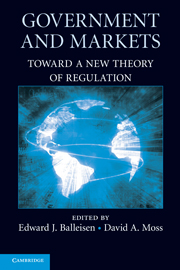Book contents
- Frontmatter
- Contents
- Acknowledgments
- Contributors
- Introduction
- SECTION I BEYOND MARKET FAILURE
- 1 Government Failure vs. Market Failure: Principles of Regulation
- 2 Effective Regulation through Credible Cost-Benefit Analysis: The Opportunity Costs of Superfund
- 3 From “State Interference” to the “Return to the Market”: The Rhetoric of Economic Regulation from the Old Gilded Age to the New
- 4 Lessons from Europe: Some Reflections on the European Union and the Regulation of Business
- 5 Confidence Games: How Does Regulation Constitute Markets?
- SECTION II BEYOND THE ECONOMIC THEORY OF POLITICS
- SECTION III BEYOND COMMAND AND CONTROL
- Conclusion
- Index
- References
5 - Confidence Games: How Does Regulation Constitute Markets?
Published online by Cambridge University Press: 20 January 2010
- Frontmatter
- Contents
- Acknowledgments
- Contributors
- Introduction
- SECTION I BEYOND MARKET FAILURE
- 1 Government Failure vs. Market Failure: Principles of Regulation
- 2 Effective Regulation through Credible Cost-Benefit Analysis: The Opportunity Costs of Superfund
- 3 From “State Interference” to the “Return to the Market”: The Rhetoric of Economic Regulation from the Old Gilded Age to the New
- 4 Lessons from Europe: Some Reflections on the European Union and the Regulation of Business
- 5 Confidence Games: How Does Regulation Constitute Markets?
- SECTION II BEYOND THE ECONOMIC THEORY OF POLITICS
- SECTION III BEYOND COMMAND AND CONTROL
- Conclusion
- Index
- References
Summary
We live in an information-rich, highly networked world, one saturated with information and choice alternatives – some trustworthy, some not. In such a society, the confidence of citizens in the marketplace is a key goal of any economic and political institution. Increasingly, our entire political system, our society, and our economy are built upon expectations – expectations of fairness, of safe and fraud-free transactions, of known risks (but also transparent, finite, and reasonable risks), of reasonable and equitable treatment (the absence of pervasive price discrimination and ethnic and racial discrimination). Effective regulation helps to maintain a structure of beliefs that make prosperity and liberty possible (or appreciably more likely). Regulation, in other words, in some sense creates the very possibility of marketplaces.
In this chapter I advance a particular version of this argument, focusing on institutions of entry regulation and approval regulation. I define approval regulation as that form of regulation in which the state must confer particular rights upon a producer or a consumer for an economic transaction to take place, where the rights are conferred at the discretion of the state and only upon the completion of a submission process in which the producer may test the product. Various forms of entry regulation can be considered as special cases of this genre. The emblematic case I have in mind is that of national pharmaceutical regulation, as carried out by the U.S. Food and Drug Administration (FDA) and the European Medicines Evaluation Agency (EMEA).
- Type
- Chapter
- Information
- Government and MarketsToward a New Theory of Regulation, pp. 164 - 190Publisher: Cambridge University PressPrint publication year: 2009
References
- 8
- Cited by



